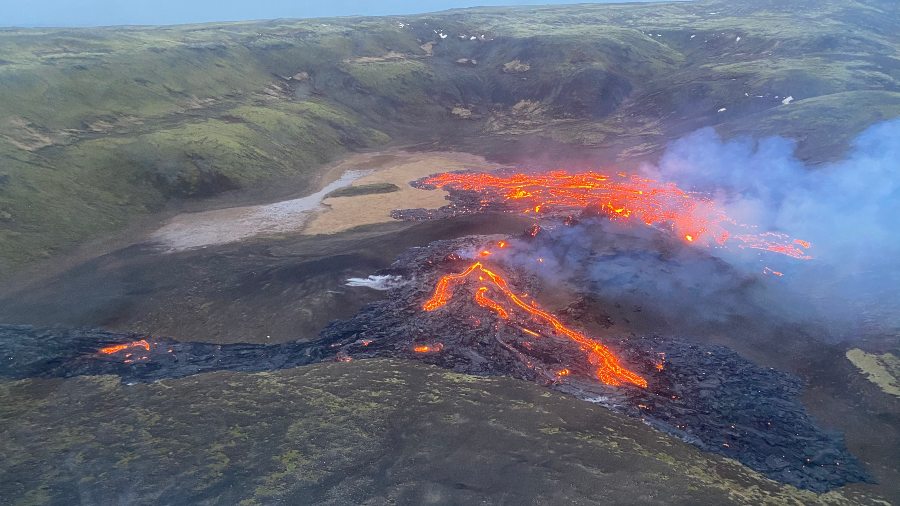
Iceland has 32 volcanoes currently considered active, the largest number in Europe. The country recorded an eruption every five years on average.
A small volcanic eruption continued on Saturday in Iceland, about 40 km from the capital Reykjavik, with no consequences other than to cause, for the first time in 800 years in that sector of the country, a river of lava and incandescent red magma.
After three weeks of intense seismic activity and an eruption alert, a torrent of lava erupted at 20:45 on Friday from a crack in the ground at Geldingadalur, near Mount Fagradalsfjall, illuminating the night with a red cloud.
In spectacular video footage recorded on Saturday by a Coast Guard helicopter, the lava was seen flowing, covering just under 1 km2, as well as blue gas outlets at the site of the eruption.

The site of the eruption is about 5 km inland. Photo: AFP
“The eruption is small and the activity has decreased slightly since Friday night. It is limited to a small area of the valley and is unlikely to cause damage, “Iceland’s latest Meteorological Service (IMO) statement said on Saturday afternoon.
What’s more: One dead, 5 wounded in Texas nightclub shootings
The Krysuvik volcanic system, which does not have a main crater, is located south of Mount Fagradalsfjall, on the Reykjanes Peninsula in southwestern Iceland.
Close the windows
Police and the Coast Guard were sent to the scene, but the population was advised not to approach.

Photo: AFP
Iceland’s Keflavik International Airport and the small fishing port of Grindavik are only a few km away, but the area is uninhabited and the eruption is not expected to be dangerous.
At this time, authorities did not report that ash fell, but fragments of tephra (solidified magma) and gaseous emissions could occur.
Police are advising residents east of the volcano to close their windows and stay home because of the risk of gas contamination.
Also: The odyssey of the pilot who with the help of monkeys survived 36 days on Amazon
For now, traffic could continue at Keflavik airport.
Gas emissions from volcanoes, especially sulfur dioxide, can be high in the vicinity of an eruption and can be a health hazard and can even be fatal.

Photo: AFP
At a distance, pollution can exceed acceptable limits, depending on the wind. The gas “can cause problems and have harmful effects on health,” the Icelandic Environment Agency warned.
Volcanic eruptions in the region are effusive, meaning most lava flows to the ground, as opposed to explosive ones that throw clouds of ash into the sky.
The Krysuvik volcanic system has been inactive for 900 years, according to the Met Office, and the last eruption in the Reykjanes Peninsula dates back nearly 800 years to 1240.
Extreme vigilance
The area has been under heavy surveillance for weeks, as a magnitude 5.7 earthquake shook Mount Keilir off Reykjavik on 24 February.
This quake was followed by an unusual number of less severe tremors – more than 50,000, most since digital recordings began in 1991.
Since then, seismic activity has moved a few kilometers to the southwest, centering around Mount Fagradalsfjall, where magma has been detected just one kilometer below the earth’s surface in recent days.
This large island near the Arctic Circle lies on the Mid-Atlantic ridge, a fissure at the bottom of the ocean that separates Eurasian and North American tectonic plates.
The movement of these plates is partly responsible for the intense volcanic activity of Iceland.
The most recent eruption took place at Holuhraun (started in August 2014 and ended in February 2015), in the Bardarbunga volcanic system, in an uninhabited area in the center of the island.
This eruption did not cause major problems, beyond those caused to the nearest cities.
But in 2010, an eruption at Eyjafjallajokull volcano threw huge clouds of smoke and ash into the atmosphere, disrupting air traffic for more than a week, with the cancellation of more than 100,000 flights worldwide, leaving about 10 million passengers stranded. of days .